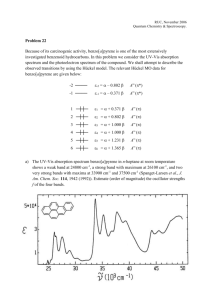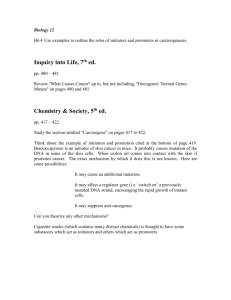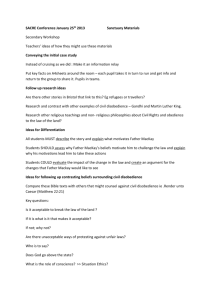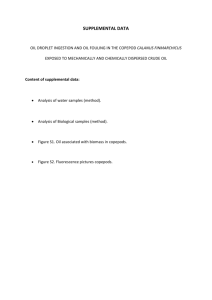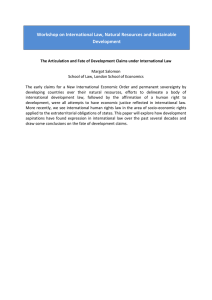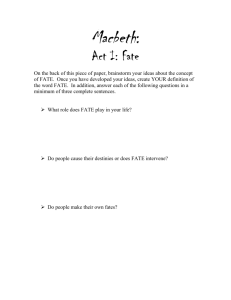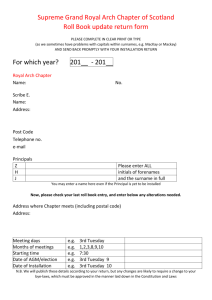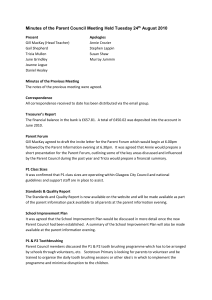Research Journal of Environmental and Earth Sciences 4(7): 731-737, 2012
advertisement
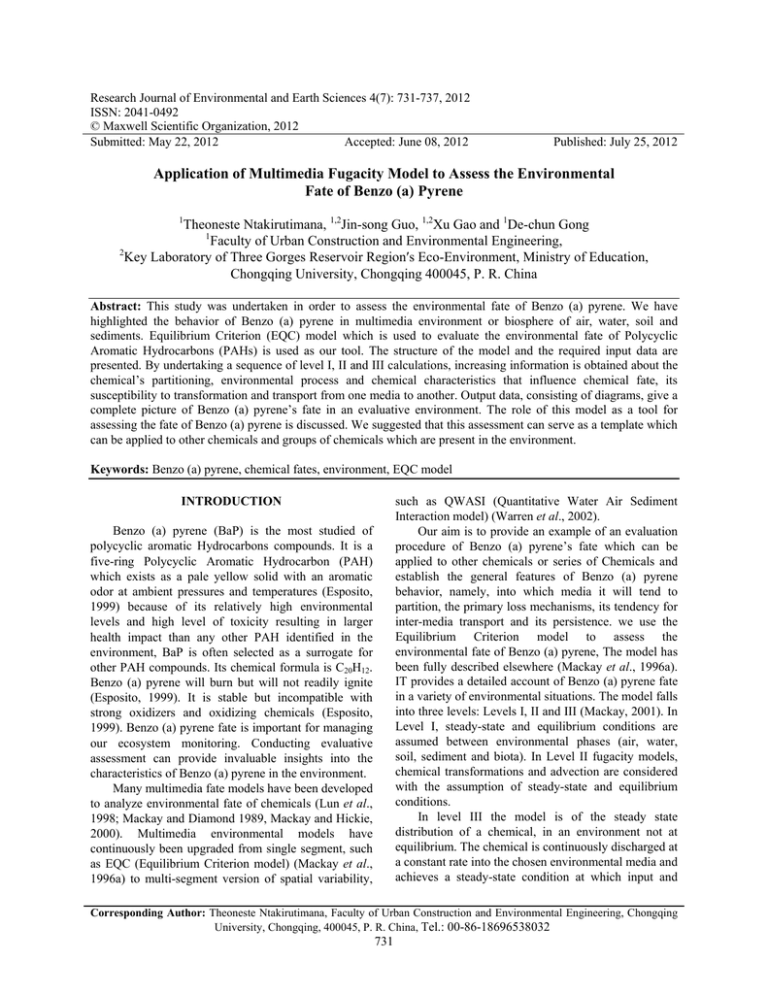
Research Journal of Environmental and Earth Sciences 4(7): 731-737, 2012 ISSN: 2041-0492 © Maxwell Scientific Organization, 2012 Submitted: May 22, 2012 Accepted: June 08, 2012 Published: July 25, 2012 Application of Multimedia Fugacity Model to Assess the Environmental Fate of Benzo (a) Pyrene 1 Theoneste Ntakirutimana, 1,2Jin-song Guo, 1,2Xu Gao and 1De-chun Gong 1 Faculty of Urban Construction and Environmental Engineering, 2 Key Laboratory of Three Gorges Reservoir Region′s Eco-Environment, Ministry of Education, Chongqing University, Chongqing 400045, P. R. China Abstract: This study was undertaken in order to assess the environmental fate of Benzo (a) pyrene. We have highlighted the behavior of Benzo (a) pyrene in multimedia environment or biosphere of air, water, soil and sediments. Equilibrium Criterion (EQC) model which is used to evaluate the environmental fate of Polycyclic Aromatic Hydrocarbons (PAHs) is used as our tool. The structure of the model and the required input data are presented. By undertaking a sequence of level I, II and III calculations, increasing information is obtained about the chemical’s partitioning, environmental process and chemical characteristics that influence chemical fate, its susceptibility to transformation and transport from one media to another. Output data, consisting of diagrams, give a complete picture of Benzo (a) pyrene’s fate in an evaluative environment. The role of this model as a tool for assessing the fate of Benzo (a) pyrene is discussed. We suggested that this assessment can serve as a template which can be applied to other chemicals and groups of chemicals which are present in the environment. Keywords: Benzo (a) pyrene, chemical fates, environment, EQC model such as QWASI (Quantitative Water Air Sediment Interaction model) (Warren et al., 2002). Our aim is to provide an example of an evaluation procedure of Benzo (a) pyrene’s fate which can be applied to other chemicals or series of Chemicals and establish the general features of Benzo (a) pyrene behavior, namely, into which media it will tend to partition, the primary loss mechanisms, its tendency for inter-media transport and its persistence. we use the Equilibrium Criterion model to assess the environmental fate of Benzo (a) pyrene, The model has been fully described elsewhere (Mackay et al., 1996a). IT provides a detailed account of Benzo (a) pyrene fate in a variety of environmental situations. The model falls into three levels: Levels I, II and III (Mackay, 2001). In Level I, steady-state and equilibrium conditions are assumed between environmental phases (air, water, soil, sediment and biota). In Level II fugacity models, chemical transformations and advection are considered with the assumption of steady-state and equilibrium conditions. In level III the model is of the steady state distribution of a chemical, in an environment not at equilibrium. The chemical is continuously discharged at a constant rate into the chosen environmental media and achieves a steady-state condition at which input and INTRODUCTION Benzo (a) pyrene (BaP) is the most studied of polycyclic aromatic Hydrocarbons compounds. It is a five-ring Polycyclic Aromatic Hydrocarbon (PAH) which exists as a pale yellow solid with an aromatic odor at ambient pressures and temperatures (Esposito, 1999) because of its relatively high environmental levels and high level of toxicity resulting in larger health impact than any other PAH identified in the environment, BaP is often selected as a surrogate for other PAH compounds. Its chemical formula is C20H12. Benzo (a) pyrene will burn but will not readily ignite (Esposito, 1999). It is stable but incompatible with strong oxidizers and oxidizing chemicals (Esposito, 1999). Benzo (a) pyrene fate is important for managing our ecosystem monitoring. Conducting evaluative assessment can provide invaluable insights into the characteristics of Benzo (a) pyrene in the environment. Many multimedia fate models have been developed to analyze environmental fate of chemicals (Lun et al., 1998; Mackay and Diamond 1989, Mackay and Hickie, 2000). Multimedia environmental models have continuously been upgraded from single segment, such as EQC (Equilibrium Criterion model) (Mackay et al., 1996a) to multi-segment version of spatial variability, Corresponding Author: Theoneste Ntakirutimana, Faculty of Urban Construction and Environmental Engineering, Chongqing University, Chongqing, 400045, P. R. China, Tel.: 00-86-18696538032 731 Res. J. Environ. Earth Sci., 4(7): 731-737, 2012 output rates are equal. This involves calculating the rates of degradation and advection, from half-lives or rate constants and advective flow rates and considering the emission. Inter-media transport processes are included. Level III models are the most widely used fugacity models. Contaminant fate and transport models based on Level III fugacity models include the EQC model (Mackay et al., 1996a), Chem CAN (Mackay et al., 1996b), CalTOX (McKone, 1993), Fug3ONT (Maddalena et al., 1995), EUSES and SimpleBOX. Level III models are also widely used in the screening phase of exposure assessments (Chuco, 2004). Hazardous contaminants cause toxicity, which depends on the duration and frequency of exposure, so a dynamic model of the hazardous substance such as Benzo (a) pyrene is of great importance. METHODOLOGY Modeling approach: The Equilibrium Criterion (EQC) model: The model uses chemical-physical properties to quantify a chemical's behavior in an evaluative environment, i.e., the media into which the chemical will tend to partition, the primary loss mechanisms and its tendency for intermedia transport and comparing chemicals. It is in the form of a computer program, deduces the fate of a chemical in Levels I, II and III evaluative environments using principles described by Mackay (2001). The EQC evaluative environment is an area of 100,000 km2, which is regarded as being representative of a jurisdictional region such as the U.S. State of Ohio, or the country of Greece. The advantage of this approach is that the models can treat a greater diversity of chemicals than conventional models, which are primarily designed for non-polar organic substances (Klecka, 2000). Moreover, the results can be shared and communicated internationally because no regionspecific data are used in this study The level I calculation: The Level I calculation evaluates the equilibrium distribution of a fixed quantity of chemical (for example, 100000 kg) between the compartments in a closed evaluative or ‘‘unit world’’ environment (Mackay et al., 1996b). It is a steady state calculation with no inflow, outflow, intermedia transport or degrading reactions. Output from the Level I calculation indicates the phases or media into which a chemical is likely to partition. It also provides equilibrium concentrations of the chemical in each compartment of the model environment and thus shows the media where concentrations are likely to be highest. The level II calculation: The Level II calculation is similar to Level I but it has a specified steady inflow (e.g., 1000 kg/h) of chemical which is balanced by advective outflows in air, water and sediment (burial) and degrading reactions in each compartment (Mackay et al., 1996a, b, c). The level requires the additional model inputs of environmental half-lives for each of the media: air, water, soil and sediment. The percent distribution is the same as in Level I but the single fugacity and the total quantity is determined by the rates of these loss processes. In addition, the Level II calculation provides an estimate of the overall residence time or persistence and it identifies the loss processes that are likely to be most important. The level III calculation: The Level III calculation has proved to be the most useful (Kim et al., 2011). It is a steady state simulation with a constant input of chemical at a user-defined rate. Similarly to the Levels I and II calculations, this rate can be illustrative or reflective of real chemical usage conditions. Unlike the Levels I and II calculations, equilibrium between environmental compartments is not assumed and intercompartmental transport processes are quantified. Expressions are now included for inter-compartmental transfer resistances. The fugacities in each compartment depend on the mode of entry which can reflect the use patterns of the substance. This simulation is regarded as the most realistic and it provides information on the likely relative importance of inter-compartmental transport rates. Model input: The important properties that affect Benzo (a) pyrene transport and fate are presented on Table 1 and are ferered as our model inputs. Henry's law constant is a measure at equilibrium of the ratio of chemical activity in the gas above a liquid to chemical activity in the liquid (Mackay et al., 1996a). The melting point is the temperature at which a compound makes the transition from a solid to a liquid phase. Vapor pressure is the pressure exerted by a chemical vapor in equilibrium with its solid or liquid phase. Water solubility is the upper limit on a chemical's dissolved concentration in pure water, at a specified temperature (Warren et al., 2007). In this study Octanol-water coefficient (Kow) indicates the potential of Benzo (a) pyrene to move from water into non-aqueous phase or into aquatic organisms and is correlated with its bio-concentration in aquatic organisms. Organic carbon partition coefficient (Koc) provides a measure of chemical partitioning between organic carbon (in soils, rocks and 732 Res. J. Environ. Earth Sci., 4(7): 731-737, 2012 Table 1: Physical and chemical properties for Benzo (a) pyrene Properties Value Molecular weight (g/moL) 252.3 Melting point (°C) 181.1 Boiling point (°C) 495 Density (g/cm3) 1.351 Vapour pressure 0.37x10-6 mPa at 20°C Vapour density 8.7 Solubility in water 3x10-7 (at T = 20°C) (insoluble) 3 Henry’s law constant (kPa.m /moL) 4.65x10-5 (at T = 25°C) Octanol water partition coefficient (log Kow) 6.04 Organic carbon partition coefficient (log Koc) 4.0 to 8.3 Emission rate for level I (kg) 100000 Emission rate for level II (kg/h) 1000 Emission rate into air for level III (kg/h) 1000 Emission rate into water for level III (kg/h) 1000 Emission rate into soil for level III (kg/h) 1000 Reaction half- live in air (h) 170 Reaction half- live in water (h) 1700 Reaction half- live in soil (h) 17000 Reaction half- live in sediment (h) 55000 Reference Lide (2004) Lide (2004) RSC (1999) Esposito (1999) Mackay et al. (2002) Mackay et al. (2002) Mackay et al. (2002) Lide (2004) Kozerski (2007) Durham and Kozerski (2007) Mackay et al. (2002) Mackay et al. (2002) Mackay et al. (2002) Mackay et al. (2002) Mackay et al. (2002) Kozerski (2008) Kozerski (2008) Xu (2010) Xu (2010) Fig. 1: Level I EQC modeling diagram for Benzo (a) pyrene sediments) and water. The higher the Koc, the more likely a chemical is to bind to the solid phase of soil or sediment than to the liquid phase (Durham and Kozerski, 2007). The Henry’s law constant indicates the potential of a chemical to volatilize from water into atmosphere. Examining the factors influencing the partitioning of the organic contaminants is very important in understanding the treatability of the organics and when conducting risk assessments associated with contaminated receiving waters. 733 Res. J. Environ. Earth Sci., 4(7): 731-737, 2012 MODEL OUTPUT AND DISCUSSION The level I assessment: Figure 1 is the level I EQC modeling diagram output of Benzo (a) pyrene, which shows that the vast majority of the chemical will reside in soil compartment 97.7% and sediment 2.17%, About 0.101% of Benzo (a) pyrene partitions into water. Much smaller amounts can be found in air (0.000959%). The low vapor pressure of Benzo (a) pyrene results in small percentages partitioning to the air compartment. The steady-state and equilibrium conditions in a closed and conservative system, as applies to level I, give a picture of the general affinity of the chemicals for the various pure phases present in the environment. The level II assessment: The level II diagram is shown on Fig. 2, which shows the same distribution characteristics as level I. The additional information provided by this level is the importance of advection and degradation or reaction phenomena. The results show that the Level II EQC modeling of Benzo (a) pyrene under equilibrium partitioning and steady state conditions, the major loss routes for Benzo (a) pyrene will be as follow, reaction in soil 94.6%, advection in air 0.228%; advection in water 2.39%; reaction in air 0.0929%, reaction in water, 2.39%; with sediment loss processes contributing about 1.68%. The overall persistence is 23772 h or with a reaction persistence of 24671 h and advection persistence of 651000 h. The level III assessment: Figure 3 gives the more complex level III diagram, which shows inter-media transport when 1,000 kg/h is discharged into each of air, water and soil. In these non-equilibrium conditions, steady-state conditions for different equilibrium criteria are deduced for the four main compartments. The Fig. 2: Level I EQC modeling diagram for Benzo (a) pyrene 734 Res. J. Environ. Earth Sci., 4(7): 731-737, 2012 Fig. 3: Level I EQC modeling diagram for Benzo (a) pyrene percent distribution of Benzo (a) pyrene in this level is fairly similar to those of levels I and II. Soil retains most of the chemical introduced in the system 71.3%. The soil compartment accumulate a larger percentage of Benzo (a) pyrene because the soil compartment in EQC has a larger surface area to receive atmospheric deposition. The relative amounts emitted to different environmental media therefore have a large effect on environmental fate and exposure. The output diagram showed that from 3,000 kg/h discharged 303 are buried in sediment, 410 advect from water, and 251 advect from air. This level also shows that the Reaction from soil is about 1577, reaction from air 102, reaction water 167 and 191 kg/h as reaction from sediment The buildup of Benzo (a) pyrene is about 54300000 kg and the overall persistence is 18085 h. There is a net transfer from air to soil of 582 kg/h, from air to water of 66.6 kg/h and from water to sediment of 494 kg/h, that is, the difference between deposition of 800 and re-suspension of 306 kg/h. The additional information provided by the level III simulation is the susceptibility of the chemical to intermedia transport which, combined with userspecified emissions, gives a more realistic picture of the fate in the generic environment. CONCLUSION EQC model is an invaluable tool for helping assessment exposure and risk for chemicals emitted to the environment. High fidelity predictions are often associated with complex mechanistic models. Application of an evaluative approach for predicting Benzo (a) pyrene fate provides a clear example of how the model can be used beneficially. It has been shown that the model can identify the relative importance of chemical specific partitioning and transformation properties. The output space diagrams of three consecutive levels provide a convenient visualization of how partitioning and transformation properties interact to determine Benzo (a) pyrene fate. As it has been demonstrated, the model is capable of identifying the dominant media of accumulation, the dominant 735 Res. J. Environ. Earth Sci., 4(7): 731-737, 2012 reactions, the role of advective losses and the intermedia transport characteristics. The EQC model is easy-to-use and act as a reliable tool for conducting an evaluative fate assessment of chemicals. This model can be applied to other chemicals and group of chemicals which are present in the environment. ACKNOWLEDGMENT This study was financially supported by the Key Grant Project of Ministry of Education of China (Grant No. 308020), Scientific and Technological Projects of Chongqing in China (CSTC2008AB7135). REFERENCES Chuco, T.D., 2004. Dynamic Integrated Modeling of Basic Water Quality and Fate and Effect of Organic Contaminants in Rivers. SISN Publisher, ISBN: 9059890159, pp: 264. Durham, J.A. and G.E. Kozerski, 2007. Soil-Water Distribution of Decamethylcyclopentasiloxane (D5) using a Batch Equilibrium Method. HES Study Number 10352-108, Health and Environmental Sciences, Dow Corning Corporation. Esposito, R., 1999. Genium’s Handbook of Safety, Health and Environmental Data for Common Hazardous Substances. Genium Publishing Corporation, McGraw-Hill, New York, pp: 10411042. Kim, J., D.E. Powell, L. Hughes and D. Mackay, 2011. Uncertainty analysis using a fugacity-based multimedia mass-balance model: Application of the‘‘new’’EQC model to decamethylcyclopentasiloxane (D5). Chemosphere, 87: 118-124. Klecka, G.M., 2000. Evaluation of Persistence and Long-Range Transport of Organic Chemicals in the Environment. Society of Environmental Toxicology and Chemistry, Pensacola, pp: 362, ISBN: 1880611228. Kozerski, G., 2007. Determination of the 1Octanol/Water Partition Coefficient of Decamethylcyclopentasiloxane (D5) by the SlowStirring Method using Gas Chromatography and Mass Spectrometry. Silicones Environmental, Health and Safety Council (SEHSC). Kozerski, G., 2008. SEHSC Response to Dr. Bidleman’s Review on Hydrolysis Studies of D4 and D5. Dow Corning Corporation. Lide, D.R., 2004. CRC Handbook of Chemistry and Physics: A Ready-Reference Book of Chemical and Physical Data. 84th Edn., CRC Press, Boca Raton, pp: 2576, ISBN: 0849305977. Lun, R., K. Lee, L. De Marco, C. Nalewajko and D. Mackay, 1998. A model of the fate of polycyclic aromatic hydrocarbons in the Saguenay Fjord, Canada. Envir. Toxicol. Chem., 17: 333-341. Mackay, D. and M. Diamond, 1989. Application of the QWSI (Quantitative Water Air Sediment Interaction) fugacity model to the dynamics of organic and inorganic chemicals in lakes. Chemosphere, 18: 1343-1365. Mackay, D., 2001. Multimedia Environmental Models: The Fugacity Approach. 2nd Edn., Lewis Publishers, Boca Raton, pp: 261, ISBN: 1566705428. Mackay, D., A. Di Guardo, S. Paterson, G. Kicsi and C.E. Cowan, 1996a. Assessing the fate of new and existing chemicals: A five-stage process. Envir. Toxicol. Chem., 15: 1618-1626. Mackay, D., A. Di Guardo, S. Paterson and C.E. Cowan, 1996b. Evaluating the environmental fate of a variety of types of chemicals using the EQC model. Envir. Toxicol. Chem., 15: 1627-1637. Mackay, D., A. Di Guardo, S. Paterson, G. Kicsi, C.E. Cowan and D.M. Kane, 1996c. Assessment of chemical fate in the environment using evaluative, regional and local-scale models: Illustrative application to chlorobenzene and linear alkylbenzene sulphonates. Envir. Toxicol. Chem., 15: 1638-1648. Mackay, D. and B. Hickie, 2000. Mass balance model of source apportionment, transport and fate of PAHs in Lac Saint Louis, Quebec. Chemosphere, 41: 681-692. Mackay, A.w., R.J. Flower and L.Z. Granina, 2002. Lake Baikal. In: Shahgedanova , M. and A. Goudie (Eds.), The Physicaal Geography of Northern Eurasia: Russia and Neighbouring States. OUP, oxford. (Chap. 17): 403-421. Maddalena, R.L., T.E. McKone, D.W. Layton Dennis and P.H. Hseih, 1995. Comparison of multi-media transport and transportation models: Regional fugacity model vs. CALTOX. Chemosphere, 30: 869-889. McKone, T.E., 1993. CalTOX, a Multimedia Total Exposure Model for Hazardous-waste Sites. UCRL-CR-111456PtI-IV, Lawrence Livermore National Laboratory, Livermore, CA. Royal Society of Chemistry (RSC), 1999. Dictionary of Substances and Their Effects Database. Royal Society of Chemistry, Cambridge, UK, on-line Database. Warren, C., D. Mackay, M. Whelan and K. Fox, 2007. Mass balance modelling of contaminants in river basins: application of the flexible matrix approach. Chemosphere, 68: 1232-1244. 736 Res. J. Environ. Earth Sci., 4(7): 731-737, 2012 Warren, C.S., D. Mackay, N.P. Bahadur and D.G.B. Boocock, 2002. A suite of multisegment fugacity models describing the fate of organic contaminants in aquatic systems: Application to the Rihand Reservoir, India. Water Res., 36: 4341-4355. Xu, S., 2010. Aerobic and Anaerobic Transformation of Decamethylcyclopentasiloxane (14C-D5) in Aquatic Sediment Systems. Centre Européen des Silicones (CES). CES Report January 27, 2010. 737
